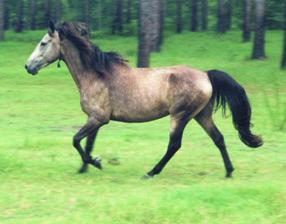
|
Return to Breed Profiles Main Page
The Kentucky
Mountain Saddle Horse
|
Once horses became commonly displaced by tractors and were few and far between as pleasure horses, Tuttle's stock, always in high demand, found its way far afield of the Natural Bridge State Park in Estill County, Kentucky, where they had become a local treasure. Throughout Kentucky, pockets of these horses survived, all believed to be descendants of a stud colt that walked out of the Rocky Mountains.
The Kentucky Mountain Saddle Horse Association was established, March 22, 1989 in Irvine, Kentucky by Robert Robinson, Jr, a life-long owner and breeder of "saddling" horses, to preserve, improve and promote these horses.
To be registered a horse must move in a natural, four-beat gait -- the Kentucky Mountain Saddle gait as it is called within the breed -- as well as in a collected "Show Walk" and a relaxed walk, maintaining good form and demonstrating a distinct difference in speed between the three.
Horses are to be shown in factory keg shoes or none at all, and no evidence of artificial gait training or devices is tolerated in the ring. Horses must display these gaits under saddle for an approved KMSHA examiner, either in person, or via video tape, to be certified as breeding stock.
Other requirements of registration are that legendary gentle disposition, a solid body color with white allowed only on the belly, legs and face, a height of at least 11 hands for Class B certification and 13.3 hands for Class A, and good conformation with medium bone.
Many bloodlines being incorporated
Although
the original Mountain Horse stock forms the basis for the Kentucky
Mountain Saddle Horse, horses from many different bloodlines are
being incorporated into the formation of the breed as well, including
Paso Finos, Tennessee Walking Horses and others that meet the
above criteria. Willing and alert, sound and smooth, these horses
promise to be the perfect all-around pleasure mounts.
The first horse registered was a beautiful chocolate stallion with white mane and tail, General Jackson, belonging to Mr. Robinson, who still stands today at Hawk Hill Farms, Irvine, Kentucky, along with two other foundation stallions, Amigo Blue and Robinson's Sundown Rocky.
Once local foundation mountain horses were registered, the KMSHA welcomed other horses possessing the traits they sought to create a larger gene pool. The famed Paso Fino stallion, Coral La CE', exemplified the traits the founders were hoping to perpetuate and was admitted as a foundation stallion. This seems a natural outcross from the original mountain stock as a 1989 blood analysis by the Gluck Research Center at the University of Kentucky, Lexington, revealed two of the three identifiable genetic markers that verified Mountain Horses as a distinct breed matched those of Spanish stock.
Very likely, the original colt from the Rocky Mountains was of Spanish origin. By expanding the genetic base for the Kentucky Mountain Saddle Horse, while maintaining the integrity of the breed's credo -- temperament and gait -- the KMSHA seeks to avoid many of the problems that go along with limited genetic material.
As interest and awareness of Mountain Horses grows, so does the role of the KMSHA. It has grown from "a handful of horses" to over 1000 members, and nearly 6000 horses registered.
For more
information contact:
Robert Robinson, Jr. President
KMSHA P.O. Box 505 Irvine, KY 40336


 Red River Bridge in Kentucky, they were persuaded to sell the colt.
That colt, or his get, eventually found his way into the string
of one Sam Tuttle. Since the bloodline had come to him by way of
the Rocky Mountains, he referred to the offspring as his "Rocky
Mountain horses". And for many, the name stuck.
Red River Bridge in Kentucky, they were persuaded to sell the colt.
That colt, or his get, eventually found his way into the string
of one Sam Tuttle. Since the bloodline had come to him by way of
the Rocky Mountains, he referred to the offspring as his "Rocky
Mountain horses". And for many, the name stuck.